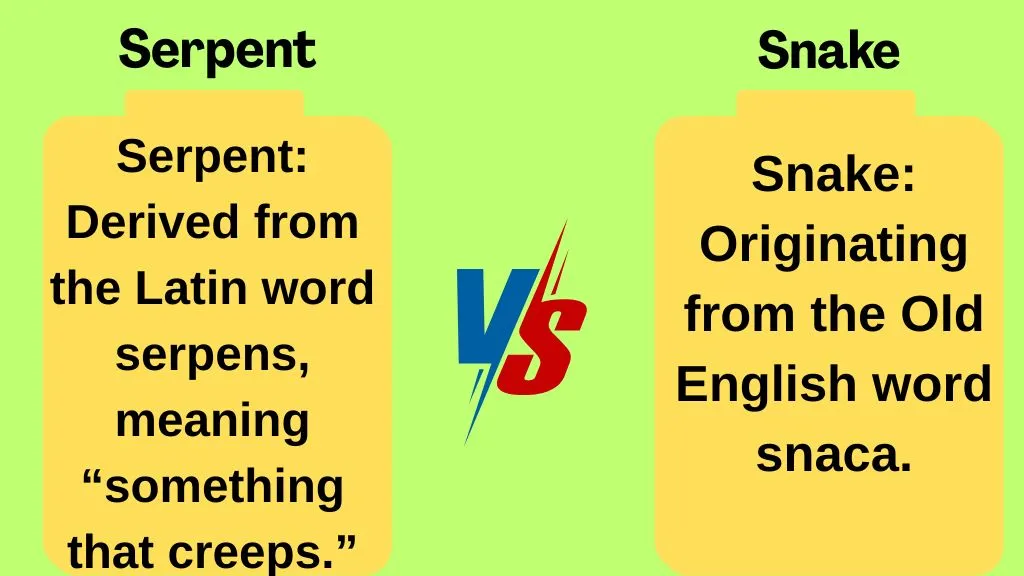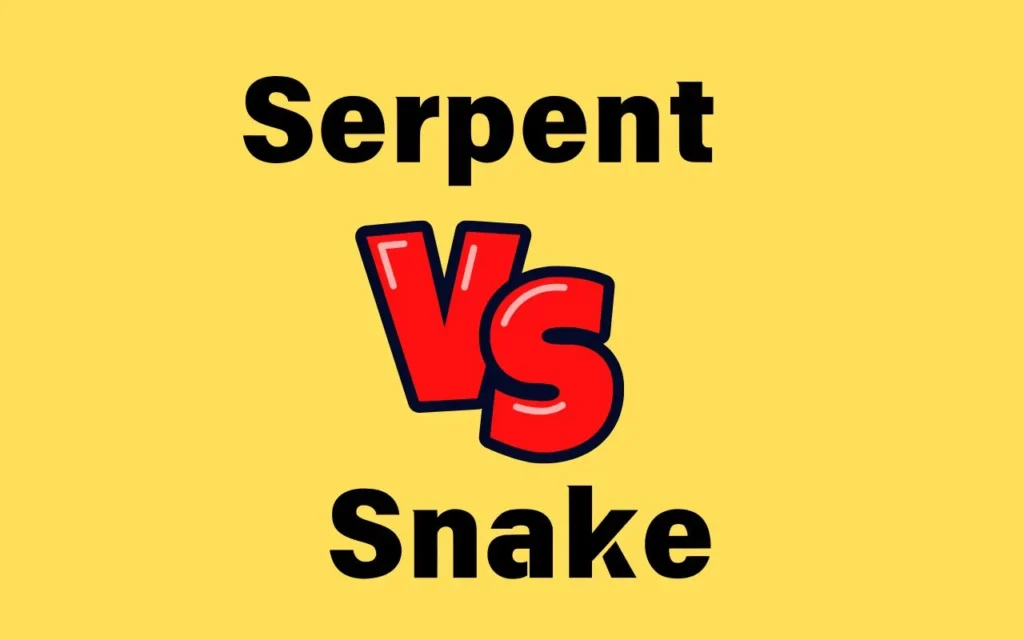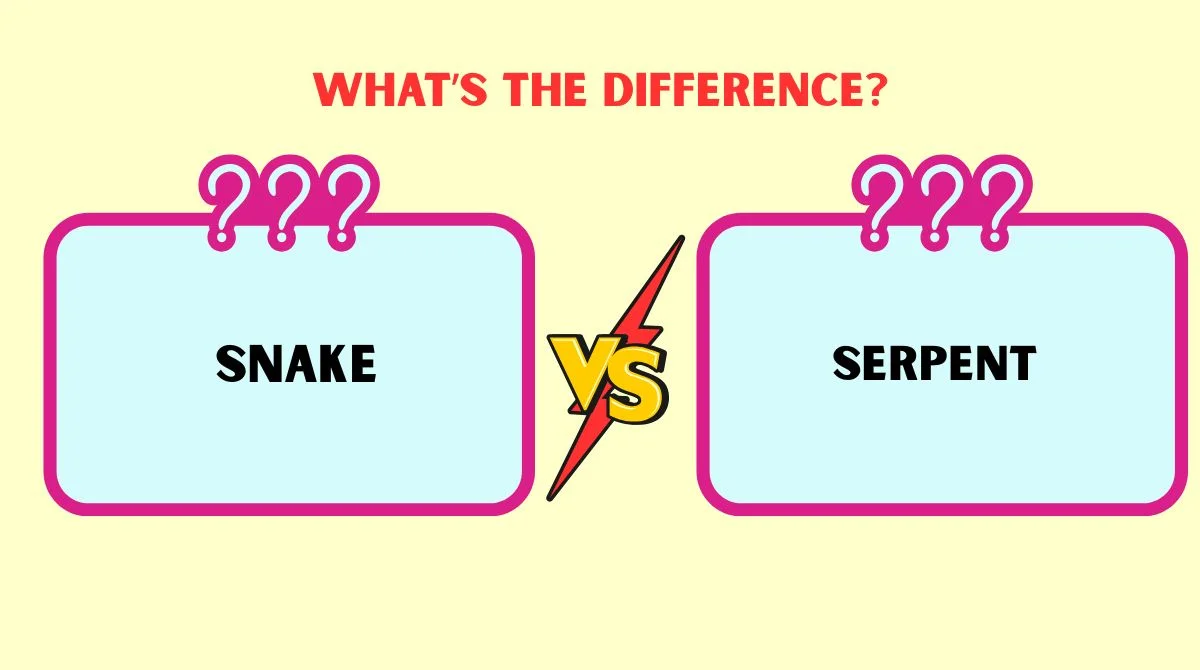Last updated on September 23rd, 2025 at 08:14 am
When it comes to understanding the difference between serpent and snake, the conversation goes beyond mere semantics.
While both terms refer to the same type of reptile, their usage, symbolism, and connotations can vary significantly depending on the context.
Are serpents and snakes the same? While they describe the same reptile, “serpent” adds a mystical, symbolic tone, whereas “snake” is used in biology. Discover their fascinating differences!
Let’s dive into the fascinating world of serpents and snakes to unravel their differences and explore their cultural, mythological, and biological significance.
Understanding ‘Serpent’ and ‘Snake’: Etymology and Origins

The words serpent and snake have deep linguistic roots, but their etymologies highlight the divergence in their meanings and implications.
- Serpent: Derived from the Latin word serpens, meaning “something that creeps,” this term has historically carried a more mystical and symbolic tone. Ancient texts often referred to serpents as creatures imbued with power and mystery.
- Snake: Originating from the Old English word snaca, the term snake is more straightforward and commonly used in everyday language to describe these reptiles in a biological sense.
Key Difference:
While snake is primarily a zoological term, serpent often carries metaphorical and symbolic weight.
The Cultural Significance of Serpents and Snakes

Throughout history, serpents and snakes have been revered, feared, and misunderstood. Their cultural significance is shaped by their mysterious nature and striking physical appearance.
Serpents in Culture:
- Frequently associated with wisdom, danger, and immortality.
- Represented in ancient artifacts and texts as symbols of power and transformation.
- Found in the imagery of many ancient civilizations, such as the Egyptians, Greeks, and Mayans.
Snakes in Culture:
- Commonly perceived as cunning or dangerous creatures.
- Often the focus of local folklore and practical advice regarding encounters in the wild.
While serpents are often revered in ancient contexts, snakes tend to represent a more grounded, realistic view of these creatures.
The Symbolism of Serpents in Mythology
Serpents have a unique place in mythology across cultures.
- Greek Mythology: The serpent appears as a guardian of sacred spaces, such as the Python guarding the Oracle at Delphi.
- Norse Mythology: Jörmungandr, the world serpent, embodies chaos and power.
- Hindu Mythology: Nāgas (serpent deities) symbolize fertility, water, and protection.
- Abrahamic Religions: The serpent in the Garden of Eden is often linked with temptation and knowledge.
Key Takeaway:
Serpents symbolize duality: wisdom and danger, creation and destruction.
Snakes in Folklore and Religion
Snakes feature prominently in folklore and religious stories, but their symbolism often contrasts with that of serpents.
- African Folklore: Snakes are seen as omens, often representing ancestors or spirits.
- Native American Beliefs: Many crews regard snakes as messengers or protectors.
- Christianity: Snakes are frequently associated with sin and deceit, as seen in the story of Adam and Eve.
Snakes, compared to serpents, are often depicted in more practical or cautionary tales, emphasizing their physical and behavioral traits.
Modern Interpretations of These Reptiles
Today, serpent is rarely used in a scientific context, while snake remains the go-to term for biologists and reptile enthusiasts. However, serpent persists in literature, film, and art as a symbol of mystery or malevolence.
- In Popular Culture: Movies and books often use the word serpent to evoke fear or mystique (e.g., “The Basilisk” in Harry Potter).
- In Science: The term snake is used universally in biological classifications, referring to over 3,000 species.
Physical Characteristics: Serpents vs. Snakes
From a biological perspective, there is no physical distinction between a serpent and a snake—they refer to the same animal. However, the word serpent often conjures up images of larger, more unfamiliar species.
| Feature | Snakes | Serpents |
|---|---|---|
| Size | Any snake, small or large | Typically evokes larger snakes |
| Appearance | Focused on biological traits | Often exaggerated in art or mythology |
| Examples | Garden snake, boa constrictor | Hydra, Nāga, mythical basilisks |
Behavioral Tendencies: How Serpents and Snakes Diverge
While the behaviors of snakes are well-documented, serpents in mythology are often portrayed with exaggerated or supernatural traits.
Real Snake Behaviors:
- Non-aggressive unless provoked.
- Solitary hunters with efficient methods for capturing prey.
Serpent Myths:
- Guardian roles, such as protecting treasures or sacred spaces.
- Depicted as cunning and malevolent in certain stories.
Defensive Strategies and Hunting Methods
Snakes have evolved fascinating methods for survival and hunting:
- Defensive Strategies:
- Camouflage to blend with surroundings.
- Hissing and striking as warning mechanisms.
- Hunting Methods:
- Constriction (e.g., boa constrictors).
- Venom delivery (e.g., cobras, vipers).
In contrast, mythical serpents are often shown as invincible beings with magical powers.
Habitats and Adaptations
Snakes inhabit nearly every continent and ecosystem, demonstrating their incredible adaptability.
| Environment | Snake Example | Adaptation |
|---|---|---|
| Desert | Sidewinder snake | Moves sideways to avoid sinking in sand |
| Jungle | Green tree python | Prehensile tail for climbing |
| Water | Sea snake | Salt glands to expel excess salt |
Serpents in mythology often inhabit otherworldly realms, emphasizing their mystical nature.
‘Serpent’ and ‘Snake’: Usage in Literature and Language
The choice between serpent and snake often depends on the tone or context of the writing.
- Serpent: Used in poetry, ancient texts, or symbolic contexts.
Example: “The serpent coiled around the tree, whispering secrets of forbidden knowledge.” - Snake: Found in scientific, casual, or modern texts.
Example: “The snake slithered across the road, startling the hikers.”
Notable Quotes:
- “A serpent lies hidden in the grass.” — Virgil
- “The snake is quick, silent, and deadly.” — Field biologists
Identifying Snakes and Serpents: A Visual and Descriptive Guide
Visual Features for Identifying Snakes and Serpents
- Snakes: Actual physical traits such as scales, fangs, or color patterns.
- Serpents: Imagined or exaggerated features like glowing eyes, immense size, or ornate patterns.
Behavioral Traits for Identifying Snakes and Serpents
- Snakes: Observable behaviors like slithering, striking, or basking in the sun.
- Serpents: Mythological actions such as speaking, guarding treasures, or causing destruction.
FAQs
What is the difference between a serpent and a snake?
The main difference lies in usage: “serpent” often carries symbolic or mythological meanings, while “snake” is the biological term for the reptile.
Are serpents real or mythical?
Serpents are real but are often depicted in mythology and literature as mystical or supernatural beings, unlike snakes, which are purely biological.
Why is the term ‘serpent’ used in mythology?
“Serpent” evokes mystery, power, and duality, making it ideal for myths and religious stories symbolizing wisdom, danger, or transformation.
How are snakes viewed in different cultures?
Snakes symbolize diverse ideas—protection and fertility in Hinduism, temptation in Christianity, and ancestral spirits in African folklore.
Can serpent and snake be used interchangeably?
They can be interchangeable when referring to the reptile, but “serpent” is typically reserved for poetic, symbolic, or historical contexts.
Wrapping Up the Differences Between Serpents and Snakes
In essence, snake and serpent refer to the same animal, but their connotations and contexts are worlds apart.
The term snake is grounded in biology, while serpent carries a rich tapestry of cultural, mythological, and symbolic meanings.
By understanding these distinctions, we can appreciate the fascinating duality of these reptiles in language and life.
Whether you’re reading ancient myths or observing wildlife, knowing when to use serpent versus snake adds depth to your understanding—and your vocabulary.
